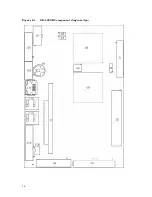
The failed device may be hot to the touch. It is usually the case that only one IC
will be overheated at a time.
Power sequencing:
The major failure of I/O chips is caused by the external
application of input voltage while the power is off. If you apply 5V to the input
of a TTL chip with the power off, nothing will happen. Applying a 5V input to a
CMOS card will cause the current to flow through the input and out the 5V
power pin. This current attempts to power up the card. Most inputs are rated
at 25 mA maximum. When this is exceeded, the chip may be damaged.
Failure on power-up:
Even when there is not enough current to destroy an
input described above, the chip may be destroyed when the power to the card is
applied. This is due to the fact that the input current biases the IC so that it
acts as a forward biased diode on power-up. This type of failure is typical on
serial interface chips but can apply to any IC on the card.
Under-rated power supply:
The board may fail to boot due to an under-
rated power supply. It is important that a quality power supply be used with
the XE–800 SBC that has sufficient current capacity, line and load regulation,
hold up time, current limiting, and minimum ripple. The power supply for the
XE–800 must meet the startup risetime requirements specified in the ATX
Power Design Guide, version 1.1, section 3.3.5. This assures that all the
circuitry on the CPU control card sequences properly and avoids system lockup.
Excessive signal lead lengths:
Another source of failure that was identified
years ago at Octagon was excessive lead lengths on digital inputs. Long leads
act as an antenna to pick up noise. They can also act as unterminated
transmission lines. When 5V is switched onto a line, it creates a transient
waveform. Octagon has seen sub-microsecond pulses of 8V or more. The
solution is to place a capacitor, for example 0.1 µF, across the switch contact.
This will also eliminate radio frequency and other high frequency pickup.
Avoiding damage to the heatsink or CPU
WARNING!
When handling any Octagon Single Board Computer, extreme care
must be taken not to strike the heatsink (if installed) against another
object, such as a table edge. Also, be careful not to drop the Single
Board Computer, since this may cause damage to the heatsink or
CPU as well.
Note
Any physical damage to the single board computer card is not covered under
warranty.
Excessive Thermal Stress
This card is guaranteed to operate over the published temperature ranges and
relevant conditions. However, sustained operation near the maximum temperature
specification is not recommended by Octagon or the CPU chip manufacturer due to
well known, thermal related, failure mechanisms. These failure mechanisms,
common to all silicon devices, can reduce the MTBF of the cards. Extended
operation at the lower limits of the temperature ranges has no limitations.
4
Содержание XE-800
Страница 18: ...Figure 2 1 XE 800 SBC component diagram top 18 ...
Страница 19: ...Figure 2 2 XE 800 SBC component diagram bottom 19 ...
Страница 20: ...Figure 2 3 XE 800 SBC dimensions 20 ...
Страница 89: ...MOV AX 0fb0bh MOV DX 0ffffh INT 17h MOV aData AL if aData 1 printf U1 jumper is ON n 89 ...





































